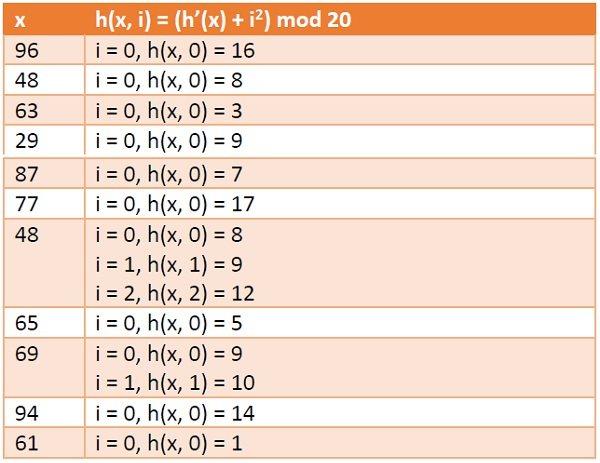
 Data Structure
Data Structure Networking
Networking RDBMS
RDBMS Operating System
Operating System Java
Java MS Excel
MS Excel iOS
iOS HTML
HTML CSS
CSS Android
Android Python
Python C Programming
C Programming C++
C++ C#
C# MongoDB
MongoDB MySQL
MySQL Javascript
Javascript PHP
PHP
- Selected Reading
- UPSC IAS Exams Notes
- Developer's Best Practices
- Questions and Answers
- Effective Resume Writing
- HR Interview Questions
- Computer Glossary
- Who is Who
Double Hashing in Data Structure
In this section we will see what is Double Hashing technique in open addressing scheme. There is an ordinary hash function h´(x) : U → {0, 1, . . ., m – 1}. In open addressing scheme, the actual hash function h(x) is taking the ordinary hash function h’(x) when the space is not empty, then perform another hash function to get some space to insert.
$$h_{1}(x)=x\:mod\:m$$
$$h_{2}(x)=x\:mod\:m^{\prime}$$
$$h(x,i)=(h^{1}(x)+ih^{2})\:mod\:m$$
The value of i = 0, 1, . . ., m – 1. So we start from i = 0, and increase this until we get one free space. So initially when i = 0, then the h(x, i) is same as h´(x).
Example
Suppose we have a list of size 20 (m = 20). We want to put some elements in linear probing fashion. The elements are {96, 48, 63, 29, 87, 77, 48, 65, 69, 94, 61}
$$h_{1}(x)=x\:mod\:20$$
$$h_{2}(x)=x\:mod\:13$$
x h(x, i) = (h1 (x) + ih2(x)) mod 20

Hash Table
![]()

